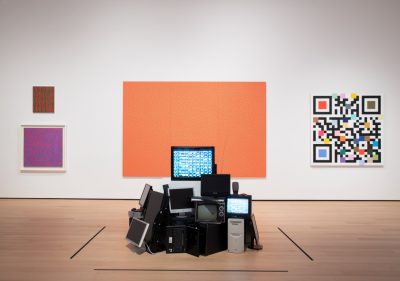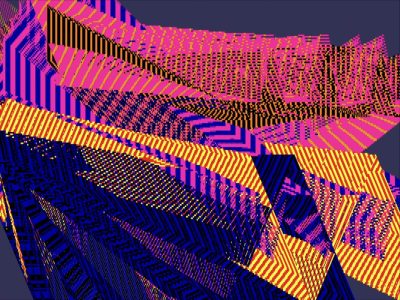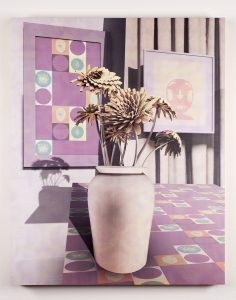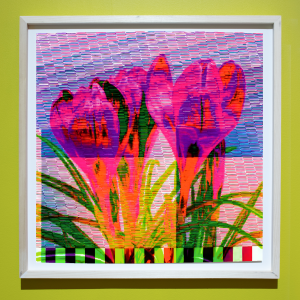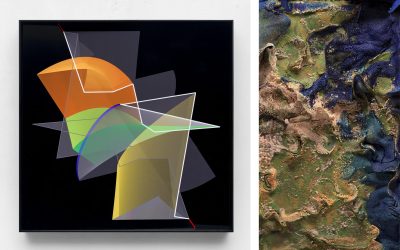bitforms gallery is pleased to announce its second solo exhibition with computer art pioneer Manfred Mohr. His new series of abstract paintings and animations continue to challenge contemporary notions of fine art process and form. The exhibition subsets opens Thursday, January 19, 2006 at 6pm with a reception for the artist, and runs through February 25. Gallery hours are 11 am to 6 pm Tuesday through Saturday.
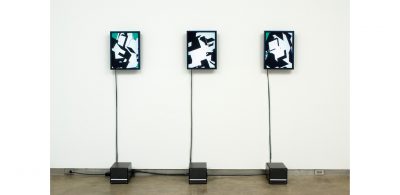

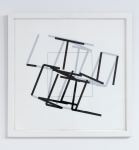
MANFRED MOHR
subsets
new paintings and animations
EXHIBITION DATES: January 19 – February 25, 2006
bitforms gallery is pleased to announce its second solo exhibition with computer art pioneer Manfred Mohr. His new series of abstract paintings and animations continue to challenge contemporary notions of fine art process and form. The exhibition subsets opens Thursday, January 19, 2006 at 6pm with a reception for the artist, and runs through February 25. Gallery hours are 11 am to 6 pm Tuesday through Saturday.
The rules of geometry, logic, and mathematics are fundamental to the customauthored algorithms which generate Manfred Mohr’s artwork. subsets presents a body of paintings and animations based on the 11-dimensional hypercube. His algorithms have been based on the logical structure of cubes, including the lines, planes and relationships among them since 1973. For the past three decades Mohr has worked specifically with the n- dimensional hypercube.
The pieces in this exhibition display a subset, or part, of a complete 11-D hypercube structure that rotates slowly in eleven dimensions before a green background. The artist’s software selects this subset of cubes from the 42240 possible cubes within a 11-D hypercube, and also determines which sides of each cube are black or white. The artworks are realized as both unique paintings in pigment-ink on canvas, and screen-based animations generated directly from the artists’ source code running on a handmade personal computer.
Having been active as a jazz musician in the early 1960s, Mohr explains his work as visual music. Mohr’s minimalist process and algorithmic understanding are influenced by French composer Pierre Barbaud, the first person in Europe to create musical compositions on a computer, and the German philosopher Max Bense who wrote extensively about a programmed aesthetics. In 1967 Mohr gave up action painting in favor of creating geometric works, which in 1969 evolved into working exclusively with computers, focusing on the logical content of his ideas. Mohr, at that time, began writing algorithms with a computer and using mechanical plotter to physically form his ideas. He also developed a special relationship, which lasted 11 years, with the Paris Institut Météorologique who granted him access to equipment on which he could work.
Mohr co-founded the “Art et Informatique” seminar in 1969 at Vincenne University in Paris, and his first major solo museum exhibition, Une esthétique programmée, took place in 1971 at the Musée d’Art Moderne de la Ville de Paris. That exhibition has become known historically as the first solo show in a museum of works entirely calculated and drawn by a computer. During that show Mohr demonstrated for the first time in public a Benson flatbed plotter and the production of computer-generated drawings.
Past exhibitions of Manfred Mohr’s work include two 2005 solo exhibitions in Germany at the Museum Kulturspeicher in Würzburg, and Galerie Wack in Kaiserslautern. Also last year he participated in group exhibitions at bitforms gallery, Seoul; the Museum-Ritter, Waldenbuch; Kunstmuseum, Stuttgart; Museum for Konkrete Kunst, Inglostadt; Galerie Schlichtenmaier, Stuttgart; KZM, Karlsruhe; Galerie Wack, Kaiserlauten; Galerie Mueller-Roth, Stuttgart; Yellowbird Gallery, Newburg and Galerie Lahumière, Paris. In 2004 he had a solo exhibition at the Digital Art Museum in Berlin. Major retrospectives of his work include the Joseph Albers Museum in Bottrop, Germany in 1998, and the Wilhelm-Hack- Museum in Ludwigshafen, Germany in 1987.
Mohr’s work is collected by the Centre Pompidou in Paris, the Joseph Albers Museum in Bottrop, the Wilhelm-Hack-Museum in Ludwigshafen, the Ludwig Museum in Cologne, the Museum for Concret Art in Ingolstadt, the Kunstmuseum Stuttgart, Musee d’Art Contemporain and Musee des Beaux-Arts in Montreal, the Stedelijk Museum in Amsterdam, the Szepmuveszeti Museum, Budapest, the Tel Aviv Museum of Art, Tel Aviv, the National Galerie in Berlin, the collection Daimler-Chrysler, Stuttgart, and many others worldwide. Mohr has had numerous solo exhibitions with both museums and galleries in New York, Zürich, Cologne, Paris, Amsterdam, Stuttgart, Berlin, Montreal, Sao Paulo, Seoul. He has participated in group exhibitions at the Leo Castelli Gallery and at the Museum of Modern Art in New York. Mohr’s awards include a fellowship from New York Foundation for the Arts in 1997, the 1990 Golden Nica from Ars Electronica in Linz, the 1990 Camille Graesser-Preis in Zürich, and the 1973 Ljubljana Print Biennial. In 1994, the first comprehensive monograph on his work was published by Waser-Verlag in Zürich, Switzerland.
